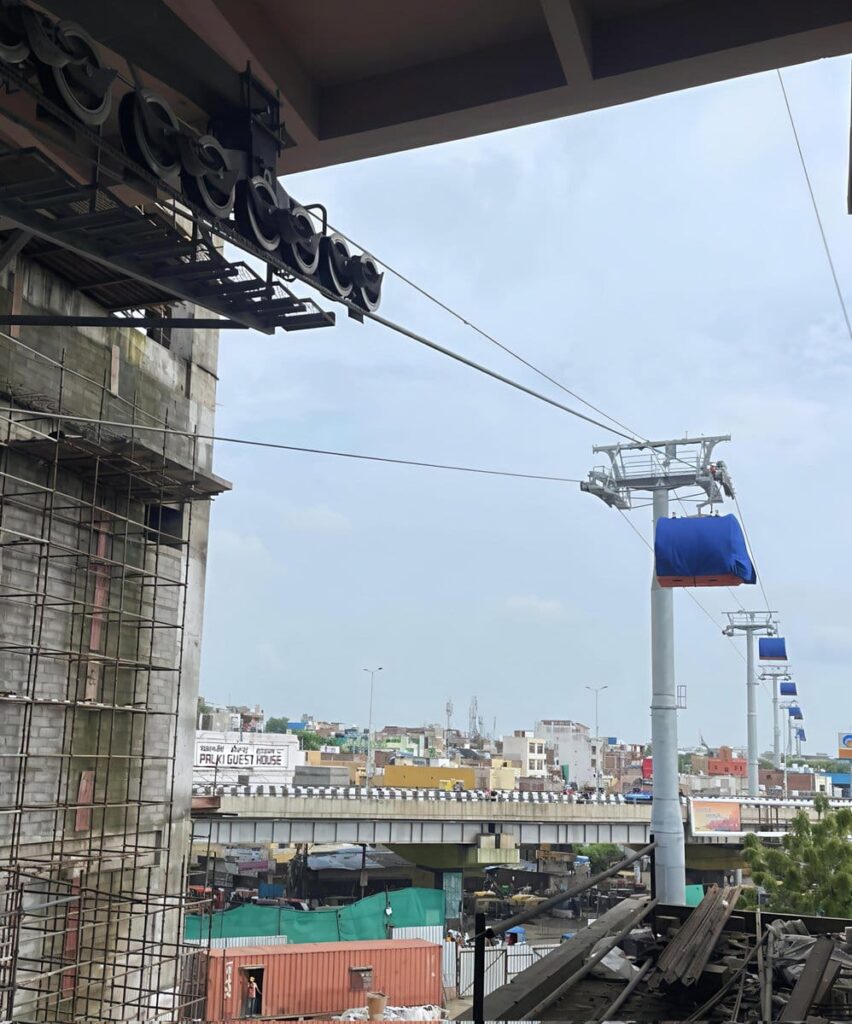The nation’s spiritual center, Varanasi, is set to host India’s first urban ropeway, which will soar above traffic. Covering 3.75 km at a cost of ₹807 crore, the project promises faster travel, eco-friendly commuting, and a new tourist attraction—marking a historic step in modernizing one of the world’s oldest cities.”
For centuries, Varanasi has stood as the spiritual heart of India, drawing millions of pilgrims and tourists to its ancient ghats, bustling markets, and narrow lanes that breathe history. Now, this timeless city is set to make history once again—not through its traditions, but through a leap into modern urban transport. Varanasi will soon become the first Indian city to introduce a ropeway service for public commuting, a move expected to reshape the way people travel within the city.
The Varanasi Ropeway Project, spanning 3.75 kilometers with an estimated cost of ₹807 crore, is being hailed as a transformative initiative that will not only ease congestion but also set a benchmark for future transport innovations in India’s rapidly urbanizing landscape.
Why Varanasi?
Varanasi, also known as Kashi, is one of the oldest cities in the world that is still inhabited. With its intricate network of roads, limited space for expansion, and rising population, traffic congestion has become a pressing concern. The city witnesses heavy inflows of both local commuters and tourists, leading to frequent traffic snarls, long travel times, and rising air pollution levels.
Traditional solutions like road widening or metro networks were deemed challenging in Varanasi’s case due to the city’s dense heritage zones, narrow lanes, and geographical constraints. The ropeway, an aerial transport system, emerged as the most practical and innovative choice.
Officials believe that ropeway connectivity will not only reduce pressure on road traffic but also offer travelers a faster, more scenic, and eco-friendly option to navigate the city.
Project Details at a Glance
- Name: Varanasi Ropeway Project
- Length: 3.75 kilometers
- Estimated Cost: ₹807 crore
First Phase: Connecting Varanasi Cantonment (Varanasi Railway Station) to Godowlia Chowk
Travel Time: 15 minutes (compared to 45 minutes by road during peak hours)
Cabin Capacity: 10 passengers per cabin
Passenger Capacity: Over 96,000 commuters per day (estimated)
The implementing authority is the National Highways Logistics Management Limited (NHLML), a branch of the National Highways Authority of India (NHAI).
This ambitious project is being executed with the technical expertise of Indian and international partners, drawing from the successful examples of ropeways in countries like Switzerland, Colombia, and Bolivia, where such systems are already an integral part of urban mobility.
Route and Connectivity
The first phase of the ropeway will run from Varanasi Cantonment Railway Station to Godowlia Chowk, covering major junctions like Rath Yatra and Kashi Vidyapith. Godowlia is one of the busiest and most congested parts of Varanasi, particularly because it lies close to the ghats and major temples, including the world-famous Kashi Vishwanath Temple.
Currently, reaching Godowlia from the station during rush hours can take anywhere between 40 minutes to an hour by road. With the ropeway, commuters will be able to cover the same stretch in just 15 minutes, while also enjoying panoramic views of the city.
Future phases are expected to expand connectivity to other crucial parts of Varanasi, further strengthening its role as a model for ropeway-based urban mobility in India.
Why Ropeway Over Metro or BRTS?
While many Indian cities have opted for metros or Bus Rapid Transit Systems (BRTS) to address urban traffic, Varanasi faced unique challenges.
Space Constraints: Unlike metros, ropeways do not require extensive underground tunneling or elevated tracks, making them ideal for heritage-rich areas with limited space.
Lower Cost: A metro project in Varanasi would have cost several thousand crores, whereas the ropeway, at ₹807 crore, is far more cost-effective.
Faster Execution: Ropeways can be completed in a shorter timeframe compared to metro projects.
Eco-Friendly: With cabins running on electricity, ropeways generate minimal air and noise pollution.
Tourist Appeal: Apart from utility, ropeways offer tourists a unique aerial view of the spiritual city, adding to Varanasi’s cultural tourism.
Global Inspirations
The idea of using ropeways for urban commuting is not entirely new. Cities like Medellín in Colombia, La Paz in Bolivia, and Mexico City have successfully integrated cable cars into their public transport systems.
- The Metrocable revolutionized connection for hillside areas in Medellín.
- In La Paz, the world’s largest urban cable car network has become a lifeline for thousands of daily commuters.
- In Bolzano, Italy, ropeways seamlessly connect mountains and urban centers.
In order to establish a standard for other crowded places like Shimla, Darjeeling, and even metro areas where last-mile connection is still a problem, Indian officials hope to duplicate and modify the Varanasi model based on these successful case studies.
Economic and Social Impact
The ropeway project is expected to generate direct and indirect employment opportunities during both construction and operational phases. Local vendors, transport providers, and tourism-related businesses are likely to benefit significantly.
Reduced Congestion: Aerial transport will take thousands of commuters off the road, easing congestion in critical junctions.
Time-Saving: Faster connectivity means improved productivity for students, office-goers, and pilgrims.
Tourism Boost: Varanasi already welcomes millions of international and domestic visitors. The ropeway will add to its charm, offering tourists a unique perspective of the city.
Cleaner Environment: By reducing reliance on fossil-fuel vehicles, the ropeway contributes to the city’s fight against air pollution.
Challenges and Concerns
The project has faced difficulties in spite of its many benefits.
- Land Acquisition: Securing land for towers and stations in a city as crowded as Varanasi is a complex task.
- Safety Concerns: Ensuring passenger safety in case of technical glitches, power failures, or natural calamities is paramount.
- Maintenance Costs: Ropeway systems require regular and specialized maintenance to function smoothly.
- Public Acceptance: As with any new system, educating citizens about usage, ticketing, and safety will be crucial.
Authorities are working on addressing these concerns, with plans to incorporate world-class safety measures, backup power systems, and real-time monitoring to ensure smooth functioning.
Government’s Vision
The government’s overarching goal of updating urban mobility while conserving cultural heritage is in line with the ropeway. Under the National Ropeways Development Programme – ‘Parvatmala’, India aims to promote ropeways not just in hilly terrains but also in congested urban centers.
Union Transport Minister Nitin Gadkari has emphasized that ropeways are the future of sustainable and inclusive transport in India, offering speed, safety, and affordability while minimizing environmental impact.
What It Means for the Common Citizen
For residents of Varanasi, the ropeway means more than just faster travel. It symbolizes relief from traffic chaos, cleaner air, and better quality of life. A daily commuter who currently spends an hour in traffic could save over 30 minutes every day—time that could be spent productively with family, at work, or in leisure.
Pilgrims visiting the Kashi Vishwanath Temple or the Dashashwamedh Ghat will find travel easier, while students of Banaras Hindu University (BHU) and nearby institutions will enjoy hassle-free commuting.
Looking Ahead
If successful, the Varanasi Ropeway Project could serve as a blueprint for other cities across India. Urban ropeways may soon find their place in hill stations, pilgrimage towns, and congested metropolitan cities.
The project represents not just an infrastructural milestone but also a cultural shift—where tradition and modernity blend seamlessly in one of the oldest cities of the world.
Varanasi’s journey from being a city of temples and ghats to becoming the first Indian city with an urban ropeway is a testament to India’s evolving approach to urban development. With a 3.75 km stretch costing ₹807 crore, this ambitious project is set to redefine how locals and tourists navigate the city’s busy streets.
As the ropeway cabins glide over the holy city, passengers will not only enjoy faster travel but also witness the seamless union of history and progress—a symbol of how India’s oldest city is embracing the future, while staying rooted in its timeless traditions.
Related News: Read More



